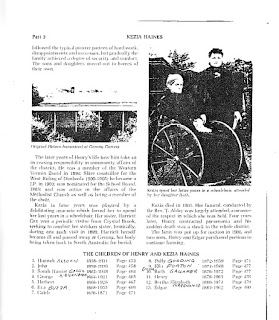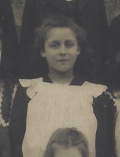Some HAINES / BAWDEN material....
1851 Census Wilts and Devon, of Haines & Bawden
|
George Haines birth certificate
|
George Haines
|
Various newspaper cuttings
|
Hannah Haines (nee Flower)
|
1841 Census of Poulshot Wilts, showing James Haines family
|
Marriage certif of George Haines & Johanna Bawden
|
>>>>>>>>>>>>>>>>>>>>>>>>>>>>>>>>>>>>>>>>>>
Some photos of Poulshot Wiltshire in the early days, albeit after the HAINES family left.
I suggest you Google Map "Poulshot Wiltshire" and have a drive around, it's a strangely elongated village, and the impression we got when we were there that is was once two separate manor farms that sort of joined up. There is also some good info online about the history of the village. (Interesting to note that the church WWI honour plaque has a couple of Haines boys on it.)
>>>>>>>>>>>>>>>>>>>>>>>>
This photo is already in the Gallery, but I've now found the text that goes with it.
>>>>>>>
List
of names to go with photo of Grandfather (George) Haines and his 12 children.
From
left to right:
Back
Row:
Emily Ada
Treloar, Matilda (Till) Priscilla Wilson,
Thomas David Haines, Florence (Floss) Elizabeth Langley, William Martin
(Mart) Haines, Feodore (Feo) Victoria Davis, Mary (Poll) Edith Longbottom
Front
Row:
Mabel (Mabe)
Jane Edmonds, Alice Maria Gardiner, George Haines, Harry Haines, Fanny Louisa
Shearer, Cecelia (Cis) Hannah Dean.
>>>>>>>>>>>>>>>>>>>>>>>>>
James HAINES and his family
emigrated to SA on the “Trafalgar” on it’s Jan to March 1850 run, but these
notes on the next trip are useful as an insight into life on board.
>>>>>>>>>>>>>>>
ANDREW JAMES POLLOCK emigrated
on the "Trafalgar" on the July-October 1850 voyage. He writes:
Dinner consists of mutton killed on board, or preserved meat, soup, sea
pie, or fowls, and potatoes, with a pudding of raisins and almonds. On Sunday
the soup is replaced by pickled salmon. The salmon is most excellent and so is
the soup invariably, also the preserved provisions. I own that I can’t get over
my disgust at the mutton and pork killed on board, though as good as can be,
and the fowls (ducks and elderly hens) are frightfully scraggy.
There is also much to amuse one on shipboard … at 4 o’clock in the
morning the First Mate, Mr Draper, calls me, with others if I am inclined. I
then get up, putting on – pray, don’t be shocked – nothing but that flannel-coloured
dressing gown you chose for me, go forward to the bow of the vessel, and don’t
be shocked again, and heartily pumped upon by one of the jolly tars. (A washing
down with cold water using a fire hose).
If not so inclined, we all rise at seven bells, half past seven, and
after the usual toilet duties, assemble at breakfast….
After breakfast we adjourn to the
quarter deck where I generally take a good long solitary walk for some miles I
should think, and as soon as I am tired of this, I go forward to the bows, and
seated upon the cat reader, watch the vessel plunging into, and rising over the
waves – a grand sight truly…. This morning from the forecastle there was a
great shout from the forecastle "there she blows" and rushing on deck
we saw two fine young wales jumping about close to the vessel. They were about
20’ long and of the finback description …. The flying fish afford constant
amusement ….
(At the back of the diary transcript is a letter written by Andrew James
Pollock to his mother after his arrival in Adelaide, giving her the benefit of
his experiences at sea, and advising her and his sisters on their travel
plans).
I write this for the sole purpose of giving you directions as far as
possible for your guidance on preparing for the voyage and your residence here.
First, as to the time when you should come out … By starting (at the
latter part of July) you have less chance of being exposed to the fearful
gales, prevalent at the Cape of Good Hope during Equinox …. Earlier in the year
you catch the winter south of the Cape, and the temperature in close latitudes
is very severe – especially after experiencing a tropical and vertical sun.
…. Don’t take a stern cabin – you
have no idea of the motion there compared with what is experienced near the
door, in case of a wave coming in. A water closet is indispensable for ladies.
The best plan is to get two smaller cabins made into one near the centre of the
ship, and all three of you occupy that. The berths should be lengthwise of the ship,
and you should be with heads to the stern. Over each at your feet should be a
small bracket to contain a vessel in case of sickness, and your being unable to
leave your beds… Underneath the berths you should store your outfits and what
you are likely to want, in galvanised cases. These are invaluable as they keep
everything from being mildewed …
Those things that you do not want on the voyage, will go in the hold,
but there put your clothes in galvanised boxes which have been soldered up, as
they could be damaged otherwise by water…
See that all holes are stopped up
in your cabin, also that under the door is close, for towards the end of the
voyage, the rats are a great annoyance. They don’t hurt anyone, but they eat up
your books etc. Few ships are without them, and I have found them nesting under
my feet upon awakening! Also for this reason, you should have your port window
fitted with a little piece of gauze wire, removable at pleasure, as the rats
almost always come in at night through the port windows.
>>>>>>>>>>>>>>>>>>>>>>>>>>>
These are a collection of HAINES papers, and you need to study each in depth to pick out the nuggets that may be of interest to you. Most of it concerns James Haines and his time in the early days of Adelaide.
>>>>>>>>>>>>>>>>>>>>>>>>>>
These are a batch of photos I was sent, simply titled "Haines Kids 1912" but nothing else, although my best estimate would make them the grandchildren of George and Johanna Haines, but of which of their 12 kids I have no idea.
At the bottom is a photo I came across of the Tea Tree Gully Baptist church in 1862, connected to the Haines families when they lived up there.
>>>>>>>>>>>>>>>>>>>>>>>>>>>>>>>











































